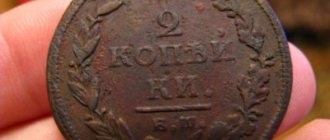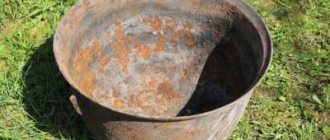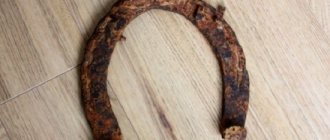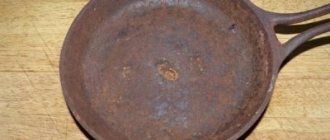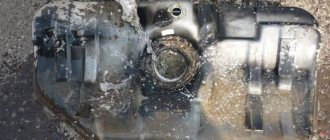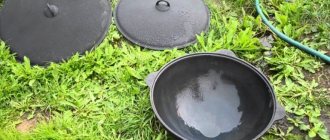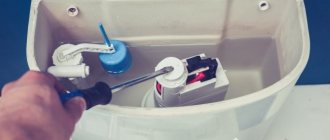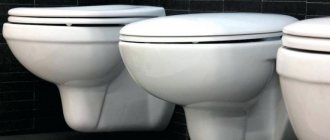The life of the driver and passengers depends on how well the braking system of a vehicle works. Therefore, it is so important to monitor the condition of all its elements, including brake discs.
If corrosion appears on them, it must be removed immediately. Read the article about why rust forms on brake discs and pads, what the danger is and how to deal with it.
Causes of rust stains
During active use of the car, rust does not appear on the discs, since they are constantly polished while driving.
However, even a short downtime of a few days leads to the formation of corrosion on the metal. This process is especially intense in conditions of high air humidity.
So, the main reason for the formation of rust on brake discs is prolonged idle time of the vehicle. These elements are not protected by anything, therefore, like any other metal parts, they oxidize.
When to clean a brake disc
The threat of corrosion spreading from the discs to other parts of the car prompts its removal whenever possible. If you have to remove a wheel, it’s worth spending a little time and cleaning the brake element - removing accumulated deposits with a wire brush and treating with a rust remover.
There are cases in which it is simply necessary to clean a rusted disk:
- Long-term parking of the car on the street. Due to the constant action of moisture, the part can literally become “overgrown” with brown growths. You will need to remove them from all surfaces. Brakes on such a disc will not work reliably; the pads will need time to wear off the corrosion layer.
- The growth of a deep layer of rust on non-working parts of the part. You can periodically clean it with improvised means. But it is better to carry out complete removal followed by application of protective compounds.
- Reduction in the cross-section of channels in ventilated discs due to corrosion of internal cavities. This leads to poor cooling of the part. Removing rusty build-up will restore air flow.
Why is corrosion dangerous and how often should it be cleaned off?
Some drivers believe that corrosion is a normal phenomenon and does not pose any threat . The main thing is to start driving and she will remove herself. In fact, this assumption is only partially correct.
Indeed, a thin layer of corrosion quickly disappears, but a thick coating that completely covers the discs cannot be dealt with in this way.
Rust is dangerous. It acts like a lubricant, increasing friction between the discs and pads. This results in reduced braking efficiency. On the road, especially when driving at high speed, this is a serious risk.
Another reason to get rid of corrosion is accelerated wear of the brake system . Corrosion acts as an abrasive, which leads to abrasion of the discs in those areas where it is most abundant.
In the future, the car will brake jerkily. If this happens, even cleaning will not be able to solve the problem. The part will have to be changed. Therefore, it is so important to get rid of corrosion in time, when the layer on the disks is still very small.
The corrosion removal procedure must be carried out in the following cases:
- The car was idle for a long time.
- The layer of rust is thick and covers non-working surfaces.
- Rust clogs the ventilation ducts. Their blockage threatens to overheat the braking system and cause rapid wear.
It is a good idea to clean the rims when changing wheels.
Preparing to replace the AP
Having determined that the TD is faulty, you need to prepare to change them yourself. To do this, you first need to buy a new spare part from a car store.
When choosing brake discs for his car, the car owner must take into account his driving style. Does he like to accelerate sharply and actively maneuver? How often does he use the brakes? He drives a lot around the city or mostly intercity trips on the highway.
The spare part from which manufacturer you need to buy depends on these factors. Discs can be standard or sports.
- Standard TD - made of cast iron, the casting is processed on a milling machine. They are ventilated and non-ventilated. Without ventilation, it is a single disc that is pressed on both sides by brake pads. A disk with ventilation is easy to distinguish - it is two disks connected by bulkheads. Ventilation occurs during movement due to air entering between these pancakes. Some of the respected manufacturers of these products are Bosh, Zimmerman, ATE.
- Sports TD - made of durable and ultra-strong gray cast iron, as well as austenitic stainless steel. These are considered to be more durable products that can last much longer and with more aggressive driving. Such discs are produced by EBC, DBA, Brembo.
The driver must remember that when the front brake discs are replaced, they must be changed in pairs, even if one of them is suitable for further use in all respects. The same rule applies to rear brakes.
This rule is explained by the fact that unequal weight of the same type of spare part on the wheels of the same axle will lead to loss of directional stability.
Thus, for repairs, two or four TDs are purchased, but in no case one or three.
In the garage or at a special technical site, the tools and materials needed for repairs are prepared in advance.
- Jack and wheel wrench.
- Keys to "13" and "17".
- Ratchet wrench.
- Large flathead screwdriver.
- Thin flathead screwdriver.
- Clamp.
- A piece of wire to fix the stupor.
- Hammer.
- WD fluid to unscrew stuck fasteners.
- Brake fluid, in case of bleeding the brakes.
- Rags.
Place the machine in a hole or on a prepared level area. Decide in advance whether the rear brake discs need to be replaced or only the front ones need to be replaced. This determines how to jack up the car. Raise the entire side or just the front wheels.
After raising the car with a jack, remove the wheel using a balloon. Clean the released brake mechanism and the surface of the hub from dirt and oil using a brush and rag.
How to remove it?
You can deal with rust on brake discs using improvised means and the use of specialized compounds. Regardless of the chosen method of combating corrosion, the key to a successful procedure is strict adherence to the instructions.
Folk remedies for cleaning
Folk remedies work no worse than professional cleaners, but are much cheaper. You can deal with rust on wheels using the following compounds:
Lemon acid .
It is diluted in warm water. For every 10 liters you will need 50 g of preservative. The disk is completely immersed in the solution and left for 24 hours. After treatment, the product is washed with a soda solution and then with clean water (read more about removing rust using citric acid here).- Table vinegar . It is used like citric acid. For 10 liters of water you will need 250 ml of vinegar with a concentration of 9%. If the rust layer is thick, then the amount of vinegar is doubled (you can find out more here).
- Orthophosphoric acid . It can be purchased at construction stores. The discs are treated with this composition, left for 15 minutes, after which they are washed off with a soda solution and clean water.
- Soda slurry . It is convenient to treat small areas of corrosion. The product is prepared in such a way that its consistency resembles sour cream. The paste is applied to the rust, left for an hour, and then removed with a damp cloth.
- Sparkling water . To combat metal oxides, you can use Coca-Cola, Sprite or Pepsi. To increase the effectiveness of the procedure, the drink is slightly heated (up to 40 degrees). The disk is completely immersed in Cola and left for a day, after which it is removed, rinsed with clean water and dried.
All of the above products are harmless to metal, so they can be used as often as necessary.
Top 3 special lineups
You can get rid of rust using converters or removers, which are sold in auto parts stores. They have different release forms, so when purchasing you need to pay attention to the following points:
- Spray. It is chosen when you need to treat a small area of corrosion. The spray is convenient to apply, since there is no contact between the skin and the active substance.
- Liquid form . Such compositions are an ideal solution for removing rust from the entire disk. The solvent is poured into a suitable container and the part is completely immersed in it.
- converter . Such compositions not only help dissolve corrosion, they provide additional protection for the metal from its reoccurrence. This is why it is so important to purchase formulations with added zinc.
Regardless of the product you choose, before using it for the first time, you should carefully read the instructions.
Top 3 popular compositions for removing rust from brake discs:
Rust converter AUTOPROFIT Galvanization .
The composition is available in the form of a solution, which is bottled in convenient bottles equipped with a sprayer. The product removes rust and prevents its reappearance, creating a durable zinc coating on the surface. For 550 ml of the product you will need to pay 225 rubles.- Rust remover SYNTIROL . The product is available in liquid form. It has an immediate effect on corrosion, removing it in 4-8 minutes. The cost of 1 liter is 450 rubles.
- Spray for removing rust Rust Remover . The composition is completely ready for use. It is applied directly to the corroded area. After just 10 minutes you can evaluate the result. One package is enough to process 5 m2. Prices are here.
How to remove using the electrochemical method?
This is a complex but effective way to combat rust. To implement it, the following components will be required:
- current source, for example, a car battery;
- soda ash solution (1 tsp per 1 liter of water);
- plastic basin;
- stainless steel;
- wires and clamps.
Procedure:
Connect the drive to the power source using the “+” wire.- Immerse the part in the soda solution.
- Place a piece of stainless steel connected to the “-” terminal into the basin. The steel and the disc must not come into contact with each other.
- Turn on the battery and make sure the reaction is started. This will be indicated by the solution bubbling.
- Wait 2 hours.
- Disconnect the power source, remove the disc, rinse and dry it.
Although this method is labor intensive, it is very effective.
Chemical methods
All products are based on acids that react with iron. Currently available in three types: sprays, liquids and gels. Sprays do little to remove heavy rust. However, they do an excellent job with parts that are just beginning to show rust. Simply spray the mixture onto the rusty surface and wipe with a rag. The leaders among sprays are Liqui Moly and Forch P321.
Liquids are used together with mechanical cleaning methods. The product must be applied to the parts and left for some time. The liquid will react with the rust, making it much easier to clean. Corrosion removal gels are also called rust converters. They do not get rid of unwanted formations, but transform them into other compounds. After conversion, the part is wiped with a rag. Products such as Tsinkar and Felix work best.
Helpful information
Brake discs are made of cast iron, so when purchasing specialized compounds, you need to clarify whether the chosen product is suitable for this type of metal.
When working with chemicals, you need to take care of personal protective equipment . It is unacceptable to remove the part from the solution with bare hands. They must wear rubber gloves.
The cleaning procedure should be carried out in a room with good ventilation.
There is a lot of useful and important information about methods of fighting rust on a car in this section.
Preparing to replace the AP
Having determined that the TD is faulty, you need to prepare to change them yourself. To do this, you first need to buy a new spare part from a car store.
When choosing brake discs for his car, the car owner must take into account his driving style. Does he like to accelerate sharply and actively maneuver? How often does he use the brakes? He drives a lot around the city or mostly intercity trips on the highway.
The spare part from which manufacturer you need to buy depends on these factors. Discs can be standard or sports.
- Standard TD - made of cast iron, the casting is processed on a milling machine. They are ventilated and non-ventilated. Without ventilation, it is a single disc that is pressed on both sides by brake pads. A disk with ventilation is easy to distinguish - it is two disks connected by bulkheads. Ventilation occurs during movement due to air entering between these pancakes. Some of the respected manufacturers of these products are Bosh, Zimmerman, ATE.
- Sports TD - made of durable and ultra-strong gray cast iron, as well as austenitic stainless steel. These are considered to be more durable products that can last much longer and with more aggressive driving. Such discs are produced by EBC, DBA, Brembo.
The driver must remember that when the front brake discs are replaced, they must be changed in pairs, even if one of them is suitable for further use in all respects. The same rule applies to rear brakes.
This rule is explained by the fact that unequal weight of the same type of spare part on the wheels of the same axle will lead to loss of directional stability.
Thus, for repairs, two or four TDs are purchased, but in no case one or three.
In the garage or at a special technical site, the tools and materials needed for repairs are prepared in advance.
- Jack and wheel wrench.
- Keys to "13" and "17".
- Ratchet wrench.
- Large flathead screwdriver.
- Thin flathead screwdriver.
- Clamp.
- A piece of wire to fix the stupor.
- Hammer.
- WD fluid to unscrew stuck fasteners.
- Brake fluid, in case of bleeding the brakes.
- Rags.
Place the machine in a hole or on a prepared level area. Decide in advance whether the rear brake discs need to be replaced or only the front ones need to be replaced. This determines how to jack up the car. Raise the entire side or just the front wheels.
After raising the car with a jack, remove the wheel using a balloon. Clean the released brake mechanism and the surface of the hub from dirt and oil using a brush and rag.
Corrosion protection Coat Z / Coated wheels - DRIVE2
The main distinguishing advantage of Zimmermann Coat Z brake discs is the anti-corrosion coating of the entire surface of the disc, including the hub. This coating preserves the appearance of the product during storage and protects the hub from corrosion during operation.
Advantages:● They have increased resistance to corrosion;● Quick installation of the wheel without the need to remove the conservation layer;● Aesthetic appearance of the wheel (especially when used with alloy wheels)
● Quality equal to or superior to the original.
Part numbers for Coat Z series discs have the same basic part as standard discs and end in .20.
Coat Z disc
Sport series perforated disc
Example of wheel designation for BMW E39:150.1284.00 - standard wheel
150 1284.20 - Coat Z series disc
150.1284.50 - Sport series perforated disc 150.1284.70 - Formula Z compound disc
Zimmermann products have also been expanded, in addition to the Formula Z sports pad series, with standard brake pads. The pads for Otto Zimmermann are made by the German company SAXID GmbH & Co.KG. (Saxid GmbH is one of the leading German manufacturers of brake systems.)
The Zimmermann product range covers the needs of virtually all vehicle models. In Germany itself, the company's products are very popular among PORSCHE car owners. Zimmermann products are of equal quality to standard products. Zimmermann wheels are purchased by such major brands as TECHTAR, BOSCH, ATE, which have quality requirements at the automaker level. Zimmermann's entire production process is certified according to DIN ISO 9000. The company does not manufacture products in other countries. Many consumers are impressed by the fact that the parts are produced in German workshops.
